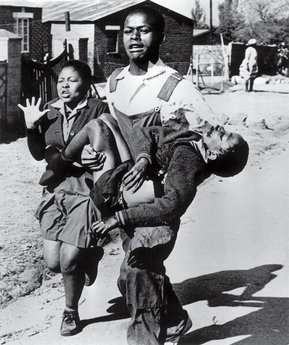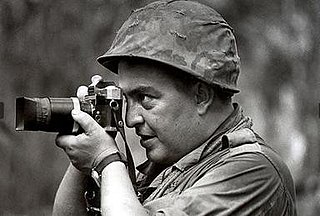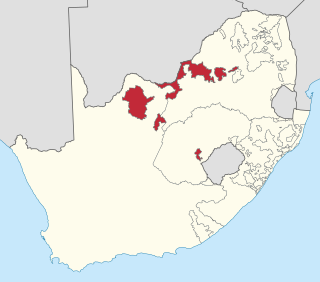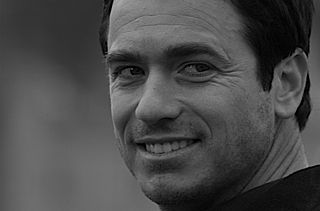
James Nachtwey is an American photojournalist and war photographer.

Kevin Carter was a South African photojournalist and member of the Bang-Bang Club. He was the recipient in 1994 of a Pulitzer Prize for his photograph depicting the 1993 famine in Sudan. He died by suicide at the age of 33. His story is depicted in the book The Bang-Bang Club, written by Greg Marinovich and João Silva and published in 2000.

The Star is a daily newspaper based in Gauteng, South Africa. The paper is distributed mainly in Gauteng and other provinces such as Mpumalanga, Limpopo, North West, and Free State.
The Bang-Bang Club was a group of four conflict photographers, Kevin Carter, Greg Marinovich, Ken Oosterbroek, and João Silva, active within the townships of South Africa between 1990 and 1994 during the transition from the apartheid system to democracy. This period included much factional violence, particularly fighting between African National Congress and Inkatha Freedom Party supporters, after the lifting of the bans on both political parties. The Afrikaner Weerstandsbeweging and other groups were also involved in the violence.

DRUM is a South African online family magazine mainly aimed at black readers, containing market news, entertainment and feature articles. It has two sister magazines: Huisgenoot and YOU.

The Death of Kevin Carter: Casualty of the Bang Bang Club, also known as The Life of Kevin Carter, is a 2004 American documentary short film about the suicide of South African photojournalist Kevin Carter. The film is produced and directed by Dan Krauss as a master's project at the UC Berkeley Graduate School of Journalism. It received a nomination for the Academy Award for Documentary Short Subject.

Sam Nzima was a South African photographer who took what became the widely-circulated and influential image of Hector Pieterson for the Soweto uprising, but struggled for years to get the copyright.

Horst Faas was a German photo-journalist and two-time Pulitzer Prize winner. He is best known for his images of the Vietnam War.

João Silva is a Portuguese-born South African war photographer. He is the last working member of the Bang-Bang Club, a group of photographers who covered South Africa from the time of Nelson Mandela's release from prison in 1990, to the country's first multiracial elections in 1994. He has worked in Africa, the Balkans, Central Asia, Russia, and the Middle East.

The 1994 Bophuthatswana crisis was a major political crisis which began after Lucas Mangope, the president of Bophuthatswana, a nominally independent South African bantustan created under apartheid, attempted to crush widespread labour unrest and popular demonstrations demanding the incorporation of the territory into South Africa pending non-racial elections later that year. Violent protests immediately broke out following President Mangope's announcement on 7 March that Bophuthatswana would boycott the South African general elections. This was escalated by the arrival of right-wing Afrikaner militias seeking to preserve the Mangope government. The predominantly black Bophuthatswana Defence Force and police refused to cooperate with the white extremists and mutinied, then forced the Afrikaner militias to leave Bophuthatswana. The South African military entered Bophuthatswana and restored order on 12 March.

Greg Marinovich is a South African photojournalist, filmmaker, photo editor, and member of the Bang-Bang Club.
Ken Oosterbroek was a South African photojournalist and member of the Bang-Bang Club. He worked for The Star in Johannesburg, which was South Africa's biggest daily broadsheet. He won numerous photography awards for his work.
The Bang-Bang Club may refer to:
The Khumalo gang was an armed group in the Joe Slovo section in South Africa. It was led by Mbhekiseni Khumalo, the founder of a small Zionist Christian sect. It was allied with the Inkatha Freedom Party.

The Bang Bang Club is a 2010 Canadian-South African biographical drama film written and directed by Steven Silver and stars Ryan Phillippe as Greg Marinovich, Malin Åkerman as Robin Comley, Taylor Kitsch as Kevin Carter, Frank Rautenbach as Ken Oosterbroek and Neels Van Jaarsveld as João Silva. They portray the lives of four photojournalists active within the townships of South Africa during the apartheid period, particularly between 1990 and 1994, from when Nelson Mandela was released from prison to the 1994 elections.

Steven Silver is a South African / Canadian media entrepreneur, producer, and director. Together with media industry veteran Peter Sussman, Silver co-founded and was the CEO of Kew Media Group Inc., a publicly listed content company that produced and distributed multi-genre content worldwide.
James Oatway is a South African photojournalist. He was the Chief Photographer of the Sunday Times until 2016. His work focuses mainly on political and social issues in Africa, migration and people affected by conflict.

The Vulture and the Little Girl, also known as The Struggling Girl, is a photograph by Kevin Carter which first appeared in The New York Times on 26 March 1993. It is a photograph of a frail famine-stricken boy, initially believed to be a girl, who had collapsed in the foreground with a hooded vulture eyeing him from nearby. The child was reported to be attempting to reach a United Nations feeding centre about a half mile away in Ayod, Sudan, in March 1993, and to have survived the incident. The picture won the Pulitzer Prize for Feature Photography award in 1994. Carter took his own life four months after winning the prize.
Judith Matloff is an American writer, journalism professor and media safety advocate. Her books are How to Drag a Body and Other Safety Tips You Hope to Never Need (2020), No Friends but the Mountains (2017), Home Girl (2008), and Fragments of a Forgotten War (1997).

Leon Francois Rautenbach, popularly known as Frank Rautenbach, is a South African actor and producer. He is best known for the roles in the films Faith Like Potatoes, The Bang Bang Club and biographical film Hansie: A True Story.














